Also due for submission this month was the Artist Library task, in which we were to examine a text that has been influential to our practice as photographers and artists. As you’ll know from previous posts, I chose to discuss Frank Miller’s Batman: The Dark Knight Returns which is a graphic novel that has held a firm grip over me since I first picked it up in 1988, just ahead of the release of Batman: The Movie from the director Tim Burton.
Brief
The essay was to be a thousand words, give or take 10% and to meet the brief:
Select one text, (e.g fiction, non-fiction, poetry, scripts, exhibition reviews etc) which is
particularly important to your own artistic path. Write 1000 words explaining your choice of
text (citing the text and referencing other artists, photographers and writers).
Other guidance we’ve received in the last couple of months also aided us:
- What text will you choose?
- How will you decide? (mind map? walk around the library? talking to others? visiting exhibitions?)
- Think about your decision-making process. How do you make decisions?
You should think about:
- What is the text about?
- What are the key arguments in the text?
- How does the text inform your practice?
- What are the limitations of the text in supporting your practice?
My response was to brainstorm a few texts that have been important to me leading to the following list:
- The Dark Knight Returns, Frank Miller 1986
- Batman: Year One, Frank Miller 1987
- Do Androids Dream Of Electric Sheep, Phillip K Dick
- TO:KY:00, Liam Wong
- Think Like A Street Photographer, Matt Stuart
Notes on Readthrough
After considering this short list I settled upon TDKR and how it has influenced me and my practice ever since. I first started off with a good read of it, alone without making any notes. Then followed it up by summarising what I saw in the story and documenting it in a few brief paragraphs, as follows. Some of these 3000+ words don’t make a lot of sense as it is notes taken as I read through again.
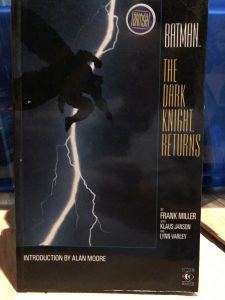
Book One: The Dark Knight Returns
Bruce Wayne starts the novel in a motor race seemingly pushing his car too far almost as if having a death wish changing his mind at the last second. The scene changes into a news broadcast explaining the hot temperatures affecting the city as well as the introduction of the key characters, Jim Gordon and Bruce Wayne. Wayne and Gordon are both elderly and retired or retiring from their chosen professions, vigilante and Police commissioner relatively.
The news shows framed in an old style CRT style shaped box talks of the heat wave and conditions growing worse as well as civil violence and gangs. It’s after this point that we get a first fleeting glimpse of the Joker before we’re introduced to former District Attorney Harvey Dent, aka Two Face. The panels of the page introducing him are split rather than being a single image, showing the cleft nature of the character, even though he is now recovered from plastic surgery and psychological rehabilitation.
At this point we move completely into darkness and start seeing scenes of fear and symbols of evil, such as a bat with fire for breath, with a sleepwalk resulting in Wayne coming face to face with a memorial to his sidekick Robin, Jason who died in the past for some reason not mentioned. Wayne’s memory is haunted by death, his own parents which caused him to seek vengeance, and the frames of this recollection are intertwined with news stories on the TV of some children who have been kidnapped by a gang called the mutants.
Scenes of gang violence in the darkness of the city night punctuated by visions of a Batman vigilante that has come out of retirement according to the tv news shows that are beamed into the mental hospital where a comatose Joker is awoken by the resurgence. Scenes set in the Arkham Hospital are very clean and white to suggest the sterile nature of the environment.
In the next part of the story we see the older Batman fighting against Two Face’s gang and dark figures and silhouettes fill the pages along with dynamic poses of the characters
Book Two: The Dark Knight Triumphant
In the next book we move into some more colourful territory with a group of gang members being meted out some justice before we see a young woman take up the mantle of Robin at the same time as we see the constant news broadcasts discussing social issues and vigilantism whilst mocking the Batman for being an elderly person. It’s at this point the gang warfare links into a story of corruption in which a senior US general takes his own life in a semiotic filled page of a dead man in a US flag whilst the news informs us that the wife of the general, who had a disease, couldn’t be treated as it was too expensive, giving us a critical note about the American health system which is based upon private treatment model, as opposed to the NHS system that we have in the UK. Miller is an American author so this point creeping into the book is an obvious reference to the contemporary issues in US healthcare.
We then move into a scene in the book that features military style conflict similar to the portrayals in paintings, photographs and films of trench warfare from The Great War. Images of the Batman sat in the “Batmobile”, basically a monstrous armoured vehicle, shot from below and surrounded by technology and weaponry is then contrasted by the leader of the mutant gang who fights half naked with no gadgets to speak of. This brute then fights with the protagonist seemingly blow for blow with an internal commentary from the batman and quips made by the mutant leader before the new Robin is forced to intervene and assist the old man who has received a punishing attack.
News broadcasts again bring us up to speed with the external events and some satirical “Robocop” style news stories, letting us know that James Olson, a character from Superman stories exists in this universe so as a result Superman must also be a part of this world. The news helicopters are trying to get on the scene of the battle so that they can broadcast live footage, something that seems normal today but back in the 80’s was a very rare occurrence in the UK. My recollections of news stories that involved Live Footage were limited to the Libyan Embassy Siege and of course the Gulf War which I saw beamed live into a pub tv whilst on a night out. Since then, this media focus on live broadcast and rolling news channels has exploded in the UK.
After the hint about Olsen we see a couple of frames of a panel in which the US Stars and Stripes morphs into the familiar red and yellow of Superman’s chest emblem as he is in discussions with the President of the US about preventing escalation of any situations caused by Wayne’s return from retirement.
Now we head into the Batcave which the pages are splattered with blood spots symbolising the fall from power and a man feeling his age and infirmity but also driven by the rage that inspired him the many decades before. With the rise of the media in rolling news channels comes the copycat phenomenon in which people are painted to be carrying out violent acts, either as a rage or to protect themselves and their businesses, again providing a commentary on the effects of media coverage. We’re reminded that Jason has died in some unspeakable manner before Wayne goes on to continue having Carrie Kelly continue as the new Robin and thus endanger her young life. Interspersed in this conversation we see black and white panels showing the senior police officers talking to one another, to me this is a black and white conversation between good and bad, right and wrong etc. After this we see Batman and the Mutant Leader battle again, with the former gaining the upper hand and then the news that the mutant gang have now become the “Sons Of Batman”, the final scene shows the victor of the fight in a muddy puddle after crushing his opponent surrounded by onlookers who immediately switch their allegiances. I feel this is apparent today in the polemic society where nuanced discussions are no longer possible and you have to be team A or Team B. This second book finishes with the newly determined protagonist awakening and wishing he was howling like the wolf.
Book Three: Hunt The Dark Knight
In the third instalment of this story, we meet a super violent neo Nazi woman called Bruno who happens to be the Joker’s girlfriend terrorising a store owner, we see the talking heads again over the top of the story panels containing the image of president Reagan hinting that this is contemporary story for when it was released in the mid 80s and not a future vision of the world. The images of a disguised Batman beating a woman with swastikas emblazoned on breasts and buttocks is a classical good vs evil narrative, whilst this occurs hints and clues to Superman getting involved on the fringes of Gotham’s society are relayed vie the ubiquitous TV broadcasts. The use of the phrases “faster than a speeding (bullet)” and “leaps a tall building with a single bound” take us back to the early days of Superman as a good and just person aiming to help humanity but we still do not see him in the frame yet.
Meanwhile Jim Gordon is seen through a TV camera view as his retirement begins and his handover to a new and keen Commissioner (Yindel), oddly inverse to the newly out of retirement Batman joined by his new sidekick. One panel here shoes us the dynamic duo flying though the air in a dynamic pose, high above the city on their way to the next lead in the case. It’s a picture that I have gone back to many times and in the early 2000’s I recreated it in an a Acrylic painting which still hangs in the smallest room of my house.
The next pages feature an explosion caused by the Joker and the new police commissioner stating that an arrest warrant is out for Batman, before we hear Wayne’s inner monologue taking the blame for all of the Joker’s victims because he let him live. The one moral stance Batman has is that he will not cross the line and kill someone, even if the crime is something that would seemingly warrant the death penalty. He has a moral compass that prevents him from “becoming like them”, the criminals he seeks to pass over to the law enforcement agencies. This page features a pair of panels showing the featureless eye of Batman, lit up by fire and destruction, paired with Joker’s pale face and detailed eye, showing the duality as if it could almost be one person split in two.
After the reminder of evil in the form of the Joker, we cut to a full page panel of Clark Kent, Superman’s alter ego, standing in a field surrounded by nature as if he is the perfect man. He talks with Wayne about having to “bring him in” accompanied by a picture of an Eagle with some prey in it’s talons. This is just before Kent disappears to answer an urgent call, as it appears a US-Soviet war is heating up, driven by a Reagan who believes the US is untouchable as they have a Superman in their arsenal.
We return to the story of the Joker being allowed on a TV Chat show to show that the rehabilitation of criminals is working, and an episode of Batman being pursued by the GCPD featuring a vertiginous scene of Gotham from the air, with batman gliding downwards. This sort of shot has sunk into my subconscious and I love shots that give the viewer an uneasy feeling of dizziness from the vertigo. The Joker’s appearance leads to hundreds of audience members and crew being killed by the poisoned gas he’s released and we see him fly above the sea of rictus-grinning individuals in a God like pose. With a theme of God like poses we see on the next page, Superman standing alongside US soldiers destroying equipment but conflicted by an inner monologue being concerned about “giants” walking the earth and the fact they will become the targets of the authorities.
The Joker then uses his association with Selina Kyle, previously Catwoman, and her Escort Agency to drug a US Congressman before he falls to his death. More symbolism in the form of the congressman being wrapped in the US flag before being stripped of it and falling to his death naked. The symbolism continues with Superman and Robins capes being attached to the silhouettes of figures in their tasks. We see a Selina Kyle beaten and bound by Joker, wearing a Wonder Woman outfit as if to provoke Superman and Batman further, both Kyle and Wayne appear older in these frames as if time is catching up with them again. Batman has to flee from the police, charged with bringing him in, and also help them with their work whilst Superman is acting as the US President’s puppet to prevent the Soviet’s from succeeding in their quest to occupy a small island. The Joker then heads off to a fairground to kill thousands of people whilst news channels talking heads discuss the virtues of the vigilante.
In this last few pages of the third book we see Batman and Robin dropping from an orange sky to stop the Joker’s deadly progress at the fairground, they prevent the Joker, now dressed in a white suit and tie with the characteristic green hair and red lips, from killing many people. All the time we’re taken back to the mini tv screens providing a soundtrack to the action, why are thugs allowed to do this? When in actual fact if it wasn’t for these thugs there would be many dead civilians. At one point a small child tells batman to “kick his…” before Batman asks him to watch his language, proving that he still believes in morals, right and wrong, even on these lower levels. He’s trying to keep the younger generations on the right track, especially since his retirement saw a rise in gang culture and malevolence on the streets of the city.
We cut to a dank set of tunnels, possibly a ride in the funfair where batman chases the Joker into all the time dodging bullets from the Joker’s gun, which Batman calls a “Coward’s Weapon, a Liar’s Weapon” before chasing him int to have the final fist fight. Batman fights the Joker until the end, but just before he kills him he stops, asserting the moral high-ground that is his standpoint in this war against criminals. He doesn’t kill the Joker but is instrumental in the final injuries that paralyse the smiling murderer. Joker then twists his body to finish his spine off and cause his own death, making it appear that Batman is a killer.
The final frame on this page shows a dead Joker and a seriously injured Batman which is seared into my memory.
Book Four: The Dark Knight Falls
The fourth chapter begins and we find out that the fight took place in the fairground’s Tunnel Of Love, which says a lot about the relationship between the two main characters, in fact, Joker has been referring to Batman throughout as “Sweet”, and “Darling” as if it’s an affectionate relationship. Batman says “goodbye” to the dead Joker by spitting on his dead corpse, which is a massive departure from his usual moralistic principles and shows that the fight has taken a lot from him, including the deaths of all of the Joker’s victims that he blames himself for. The dark tunnels and light being shone on the Joker’s hideous face are cinematic and one of the reasons I love silhouette photography. The story switches to following the 13 year old Carrie Kelly as Robin being pursued by a news helicopter before we see Batman being haunted now by a fire-consumed Jokers skull still “laughing” at him.
Batman is now healing after his aged butler Alfred has fixed up his wounds and we see that the Soviet army have launched a Nuclear weapon at the island of Corto-Maltese which Superman now has to divert to save the lives of Twenty Million people. We switch to Silhouetted figures again, with the red cape, yellow belt and chest emblem being the only details allowed to jump out of the monochrome page. An enormous electro-magnetic pulse kills the electricity and systems around the city, a plane crashes into a tower building and the mutants/Sons Of batman are talking of razing the city to purge it, but Batman appears on a huge, black horse like an old general to take charge and use these outcasts of society to help society, by guiding them in the ways of controlling crime by using unorthodox methods. At the same time in a different location we see a weakened superman who is cursing the human race for using nuclear weapons on top of the usual selfish behaviour they normally exhibit. He needs to reach the sun to recharge himself before he can continue to hold Bruce Wayne at fault for causing the issues in the city beneath. As Superman loses his powers and becomes a shadow of his former self, we see the colour drain from his image until the saturation of the red, yellow and blue is almost different shades of grey. With the city’s residents panicking and turning on each other we see Batman, Robin and the Sons Of Batman arrive on their horses and by foot to control the situation and prevent further bloodshed. Batman charging at the reader on this steed almost seems to leap out of the page and is also another image that sticks in my mind, almost thirty years before we see the Avengers movies follow the same sort of composition on film.
In the final set piece battle, Batman must take on Batman who is standing up for “Truth, Justice and the American Way” whilst Batman uses his unlawful methods. We see more colour in these pages with Batman plugged into the grid to power up his super armoured suit in a battle to the death, literally. A shot from this page shows Batman under a streetlight awaiting the confrontation which I have also found to appear in my photographs over the years since. I have many images of the spot of a streetlight on the ground, or even on flood waters that really stem back to his vision when I was a teenager. Another character we meet now is Oliver, a now one armed archer, who was previously the “Green Arrow”. Fittingly he shoots a green arrow, containing the kryptonite that weakens Superman so that batman can finish the fight off. Bruce mentions that he is now viewed as “a political liability” whilst Superman is “a joke” telling us that they are just characters in the wider story of the world outside of these pages.
just as Batman appears to beaten Superman, there appears an ECG trace on the page which then flatlines, with Batman falling to the ground, dead. Alfred destroys the Batcave and suffers a fatal stroke, ending his service to the Wayne family. A funeral consisting of the characters in the book thus far is surrounded by the tv broadcasts detailing who Batman was and that any evidence of his methods are gone with the destruction of the manor and the cave beneath.
The ECG makes a reappearance when Superman, attending the funeral as Clark Kent hears Wayne’s heart restart and we find out that this was all part of a carefully staged plan to allow Wayne to retire again, but not completely. He utilises the lost souls that were previously drawn into Gangs as the new vigilantes that will continue to prevent thieves and murderers from escaping justice.
Themes
Some of the themes that came through in the reading of this book stood out to me and I listed them so I could pick out a couple, as going through all of them in a short essay of only 1000 words was highly unlikey.
Age, Retirement, Crime and Punishment, Rehabilitation Of Criminals, Sexism, Child Endangerment, Mass Murder, Mental Health, Duality, Sacrifice, Nuclear War, Political Corruption, Death, Blame, Guilt, Vigilantism, Gang Warfare, Media Intrusion, Rolling News Coverage, US-Soviet Relations, Duty, Friendship, Law & Order, Sleep Disorders, Narcissism, Conspiracy Theories
Inspirations
Some of the images in the book and the methods used to tell the story by Miller, Klaus Janson and Lynn Varley working together have found their way into my photography. Whilst at the moment of capture I may not be consciously thinking of the process and the result aligning to this form of art, it does appear in my image library.
- Silhouettes
- Colour Popping (I’m not a massive fan of colour popping)
- Colour Palettes for different people
- Splitting frames for duality
- Adult story
- Satirical humour
- Onomatopoeia without stupidity
- Strong Single Page images
- Angles of images looking up and down
- Telling stories with pictures
The Essay
Putting this altogether in with a tonne of reference led me to an essay of just under the 1100 maximum limit and even then I feel that there is so much I want to talk about but was unable to get across in my short piece of writing. Instead I focussed primarily on the use of the TV Screens in the comic panels being used for narration, exposition and verbalising events in the pictures. I referred to Robocop, the Verhoeven movie from 1987 ( the year after TDKR) in that they also use a News Channel to much the same result of moving the story onwards without the main protagonists having to explain everything. This followed into the portrayals of Ronald Reagan as a warmonger and incompetent buffoon in the book, taking me back to my years of watching Spitting Image and even Genesis’s Invisible Touch video featuring Reagan and Margaret Thatcher in bed together.
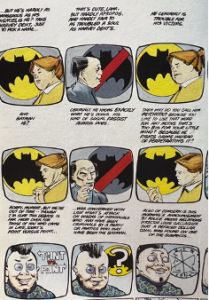
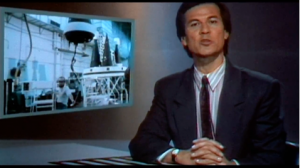
News channels like those portrayed are ever more prevalent since the times of this book being produced and in some of the referenced documents, journals and books they point to the spread of polemic arguments and hysteria when large events are taking place in the real world. There are links to the TV channels in the story as when they talk about changes in the weather becoming hot and unbearable, there are changes in Bruce Wayne’s behaviour that sees him returning to the role of Guardian Of Gotham.My essay also touches on the difference between right and wrong and how, often it’s pragmatic to have a sliding scale between the black and white approach, Batman is a necessity in the corrupt and crime ridden city of Gotham but ultimately it’s against the law and he’s always at risk of being arrested and treated as a criminal himself.
I discuss the use of framing of characters in the book using special panels in the book. I’m sure that back in 1988 when I was but 15 years old, I did not realise that the panels featuring Harvey Dent were split across two panels to emphasise the split personality and duality of his character even though his physical deformity had been repaired by plastic surgery.

This use of panels in pages along with the strange angles in some frames have embedded themselves in my memory, a shot looking up at the Batman riding in on a big horse to distort the perceived size of him or the shots of him dropping into the tower blocks of the city from above. These images make the scale of the city or characters seem to pop out of the page, or sink into the page almost 3 dimensional. I have a photo that I referenced in the essay of New York City at night from above, standing on the viewing deck of the Empire State Building after midnight that reminds me greatly of Gotham City. Miller also uses the left hand side of a two page layout for a single page image. He does this throughout the book to exaggerate the size and scale of the image as well as have it be a surprise when you turn the page over. When you flip a page, you immediately see the right hand page being uncovered but your eye then travels to the left page being slowly uncovered to follow the story. That’s when it hits you, bang, Batman and Robin flying through the air together in an iconic image.


The lighting of the characters in the story uses harsh shadows, silhouettes and even blown out colours as if the page is not able to render the different levels of light and dark in the image. It fits in well with the arguments continuing throughout the book, light/dark, black/white, good/evil. I find that I use silhouettes in many of my images that sit within my library where I will frame a person to be backlit by natural light or even traffic and shop lighting. A favourite place for this style of photo for me is a museum or gallery when there are often dark rooms with brightly lit corridors outside. Shadows and silhouettes are aplenty in this hunting ground for me. This fascination I think is partly due to TDKR too.
At one point in the essay I also note how I’ve been inspired in the past by the imagery of comic books, indeed I have painted many scenes from Batman comic books or graphic novels onto canvas that adorn different parts of my house, mostly in the loft. Some cyanotypes I made in 2022 also featured a caption in the corner of the frames to add some context that wouldn’t have been there otherwise.
I also make a quick point about the limitations of the book, some of which are apparent but the presence of female characters is a bit weak, other than Robin who is now embodied by 13 year old girl, Carrie Kelly. The other strong female character is the new commissioner of police, Ellen Yindel, but she has been drawn in an androgynous manner as if it would be a step too far to have a truly feminine police commish.

Some of the references I used in the essay are found via the University of Wolverhampton’s Library resource page, some using Google Scholar and many others from random books and web journals. I even have a graph in there to show how U.S. uses of force increased in the Reagan era which possibly led Miller to satirise the leader of the U.S. at the time.
Summary
In summary then, this book is instrumental in my becoming an artist and a photographer. The book has given me a doorway into the mythos surrounding the complex character of Bruce Wayne/ Batman and helped me learn lots of useful facts over the years also. I’ve drawn inspiration from the story, the characters, the art, and the way that the story was told in different strands using differing colours for different characters. The hand in came and went with the work being submitted in good time and although it was a short essay with little room to explore all of the ways it inspired my practice I hope that my passion and love fo rthe medium has been captured.
We’ll now wait until the new year to see what kind of mark it gets I guess.
Below is a gallery of some of my digital art, created in the mid 90’s on a Commodore Amiga and then a PC in the early 2000’s, whilst not the greatest at painting and drawing I did enjoy the process of creation and all come about down to this one graphic novel. Further below that is a gallery of some of the canvases I’ve painted too.
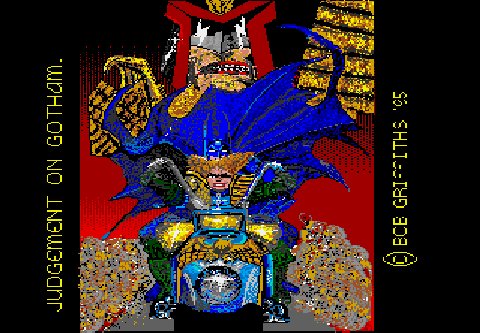

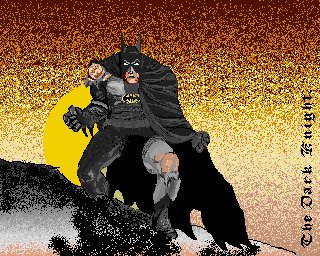


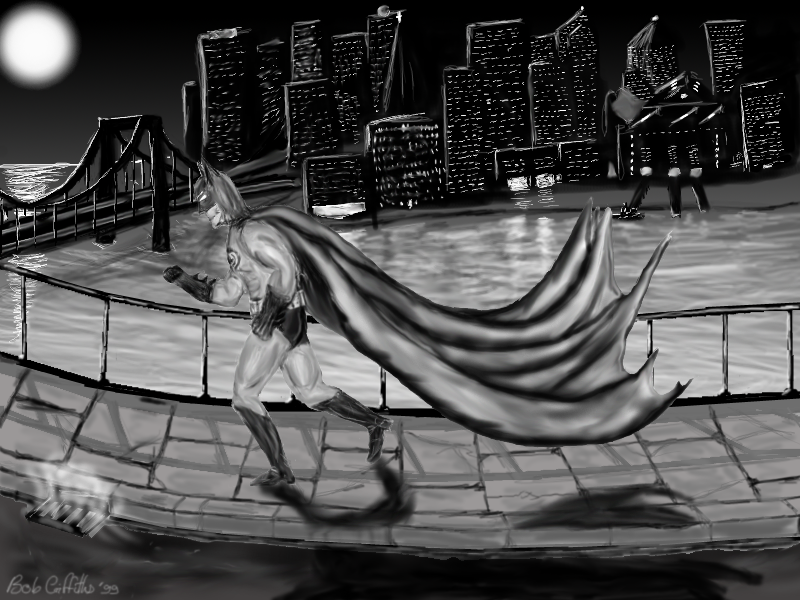

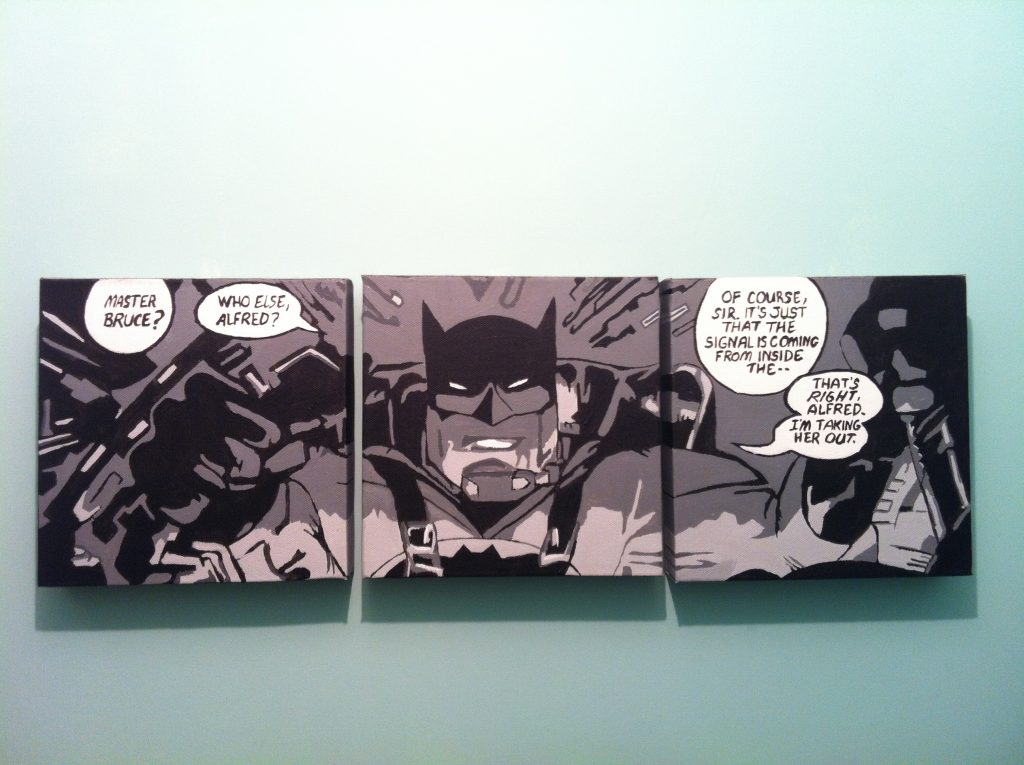
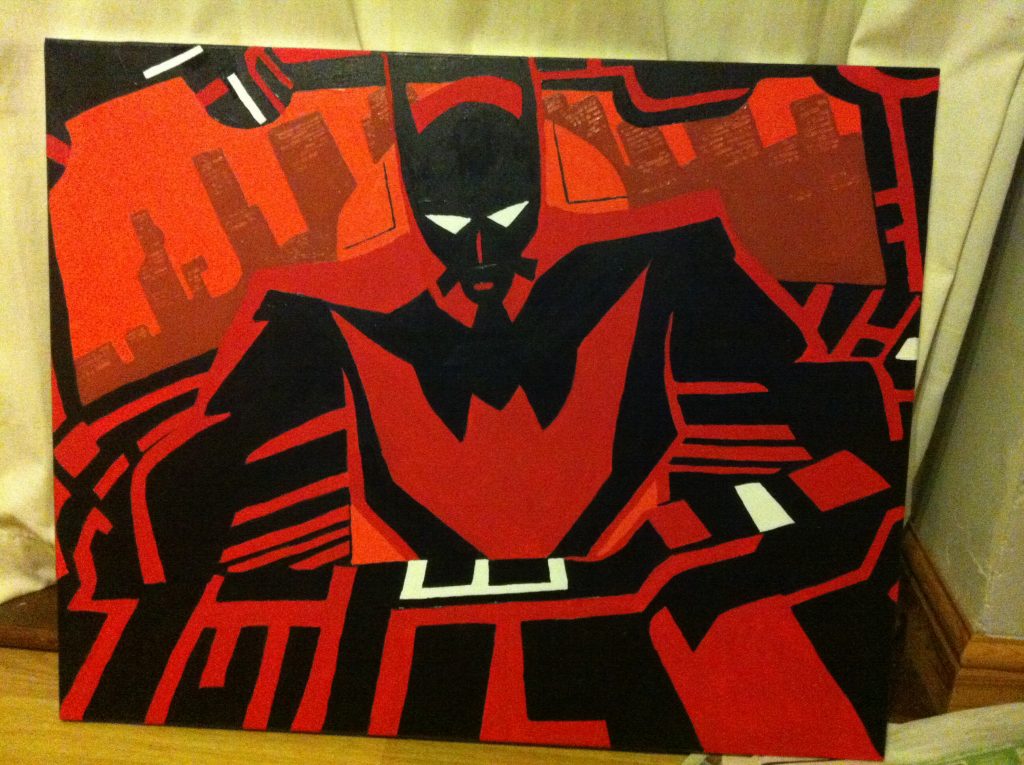
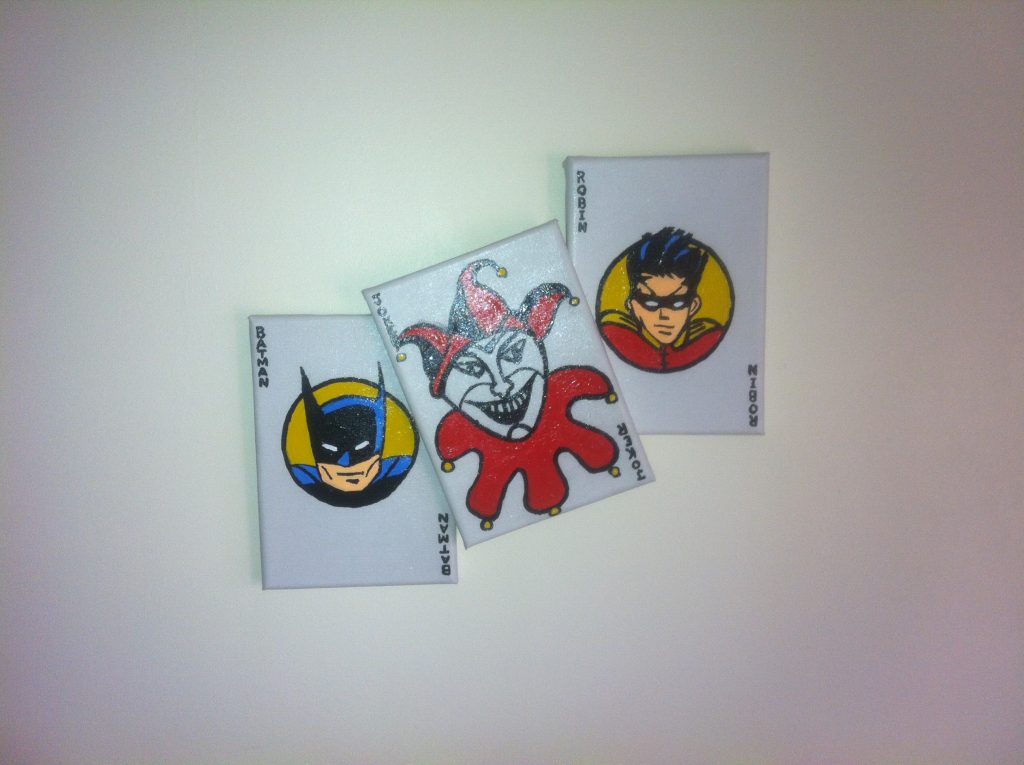

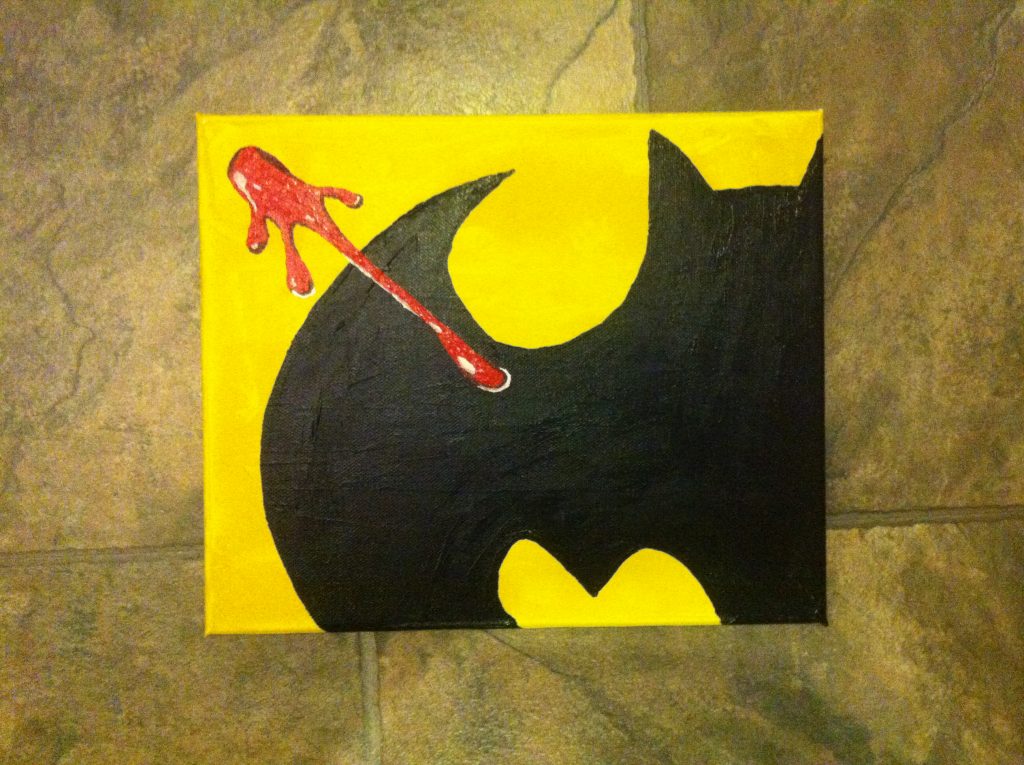
Be First to Comment